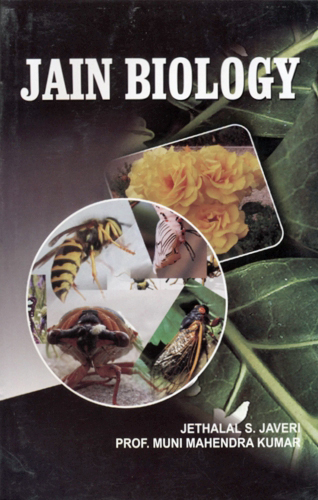Scriptures first divide the plants, as they do all sthāvaras, in two kinds—subtle and gross, and both of them are either fully developed or partially developed. This criterion for division appears to be unique with the Jains. Here the subtlety has no reference to the size of the Organism - whether microscopic or megascopic - but is associated with a specific sub-species of body-making (nāma) karman called "sukṣma nāma karma" and "bṣdara nṣma karma". The organisms which exist under the fruition of the former are designated subtle (sukṣma) and the other ones are gross (bṣdara). The subtle sthāvaras are distributed all over the cosmos but the gross ones are found only in a part of the cosmos and not everywhere. Again the fully developed and partially developed refers to the initial stage of organisms when beginning a new life after metempsychosis. All organisms have to undergo a progressive process of attaining biopotentials (paryāptis) in six stages:
- The first is āhāra paryāpti—the union of the soul with the fertilized ovule; this is instantaneous;
- The second is śarīra paryāpti—adoption of the ovule as its physical body by the soul; These are followed by the acquisition of the capabilities of perceiving through sense organs, breathing, communicating and thinking. Until the consummation of all the potential faculties, the organism is partially developed (aprayāpta). After consummation it is fully developed (paryāpata). Since there is a possibility of the organism dying before becoming fully developed, this is made a basis of division. Thus partially developed is only a transitional stage and so there are no further divisions which leaves the gross and fully developed plants.
The gross and fully developed plants are of two kinds:
- Plants in which each soul possesses its own physical body
- Plants in which many soul share one common physical body
This is again a unique principle enunciated by Jains. Besides the fact that there are innumerable living organisms in each living plant—the integral plant is one soul; separate soul pervade each organ (leaf, flower, fruit etc.) while some organs have innumerable souls—a class of some plants are such that in some of their organs, each soul does not have a body of its own but a large number—infinity—of soul are compelled to share a common body. They come into existence together, breathe and live together and die together. Onions, garlic, ginger, āluya (which is not to be confused with ālu or potato) are such plants.
Those which severally have their own body are again divided into twelve categories in accordance with their morphology: (these are given in the section "Biology in Prajñāpāna Sūtra").
Those plants in which many souls have to share a common body are also given in that section. According to Biology, these are:
- Rhizine—a thick stem which grows horizontally under ground; common examples are:ginger, canna.
- Corm—a round fleshy stem which grows upright underground; common examples are: elephant's foot, sword lily.
- Stem tuber is the swollen tip of an underground branch. Potato is the best example of stem tuber.
Bulbs of onion and garlic are in reality modified shoots with food stored in leaf bases and the buds respectively. A rule of thumb is—(a) whatever grows underground, roots bulbs tubers; (b) immature leaf in which central vain or mid rib is no discernible—are organs in which a common physical body is shared by infinite souls.This is the reason why onions, garlic etc., are regarded as taboo by Jains. Plants which grow from plants (vṛkṣayonika vṛkṣa) treated in Sūtrakṛtāṅga Sūtra, refer to 'epiphytes' and 'parasotes' of biology. According to the former epiphytes and the like grow not only from trees but also from grasses, herbs, shrubs, and all other kinds of plants except 'kuhaṇas' such as Aya, Kaya, Kandu, Uvvehaliya, etc., because there are no Ayas originating from Ayas but only through their seeds. Again there is similar exhaustive treatment for water plants in the former but not much importance given to them as a special category in Biological treatment. The scripture gives the following varieties of water plants:
Udaga, Avaga (agrassy plant growing in marshy land—Blyxa Octandra), Sevalā (Vallisneria), Kalambuka (kadamba—Nauclea Kadamba), Kacchabhaniya, Kaseruka (Scripus Kysoor), Utpala, Padam, Kumuda, Nalina (all four being well-known varieties of lotus, Subhaga, Saugandhika, Puṇḍarika, Mahāpuṇḍarika, Śatapatra, Sahasrapatra, Kalhara, Kokanada, Aravinda and Tamarasa (all varieties of lotus), Kamalamūla, kamalanāla, Puṣkara (stalks and fibres of lotus).
Morphologically, the Scriptures enumerate the following plant organs: roots, bulbs, stem (trunk), branches, twings, leaves, flowers, fruits and seeds. Beyond giving the names, the scriptures assert that each of these organs are animated by one or many souls. We do not come across much information about different types of roots such as true and adventitious roots; epiphytic and parasitic roots etc as given in Biology. Same is the case with the other organs.
In the Prajñāpāna Sūtra mention is made of two types of trees whose fruits are (a) with a single seed—Egaṭṭhiyaya—(mango, jamun) and (b) with many seeds—bahubiyagaya—(tomatoes, pomegranates).
In Biology, however, the fruits are of four types:
- Caryopsis - each fruit functions like a seed; maize, rice, wheat and in all grasses, the fruits have only one seed with a dry pericarp.
- The drupe—fruits of mango, peach, pericarp covers a single seed; it has a skin, pulp, and hard carp.
- The berry—fruits of tomato, chikoo; percicarp has outer skin and pulp with many seeds scattered within.
- Legumes—peas, beans and other pulses; a dry pericarp with many seeds.
SEED is the origin as well as the ultimate organ of the plant. Only Sutrakritanga Sutra deals briefly with seeds mentioning four types according to their location in the plant. Biology gives many details which include the process of germination.
 Jethalal S. Zaveri
Jethalal S. Zaveri
 Prof. Muni Mahendra Kumar
Prof. Muni Mahendra Kumar

